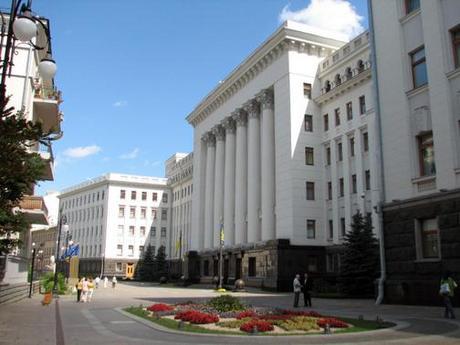The building of the Presidential Administration
The majestic building that raises in Pechersk over Lipki, on Bankova Street, 11, was built in 1939 for the staff of the Kiev military district. It is the monument of Kiev culture and architecture. The building project was created by the famous Kharkov architect Grigoriev, who combined two styles in the structure: classic and Ukrainian Baroque.
After Ukrainian independence from the Soviet Union, then President Leonid Kravchuk established the Administration of the President of Ukraine on December 13, 1991 as an advisory body to the President. The Administration is headquartered on No.11 Bankova St. in Kiev. Under President Yushchenko, the administration was reorganized into the Secretariat on January 24, 2005 in accordance with Clause 28 of Article 106 of the Constitution of Ukraine. President Viktor Yanukovych restored the old name Administration of the President of Ukraine on his first day in office, February 25, 2010.
The building was built in 1936-39 by the design of the Kharkiv architect Serhiy Grigoriev for the headquarters of the Kiev Special Military District. The author of the design was able organically unite elements of a classical style and Ukrainian Baroque.
First that may strike visitors it is the unbelievable thickness of building's walls. Specialists explain that it was due to restrictions to build administrative buildings in the Soviet Union of 1930s which forced to dodge it by building a new structure on the already existing foundation. The new design made a great use of the symmetric campuses of the previous Shile's design of 1870s.
The new building was considered a reconstruction with some new elements. Its wings were extended, while in the center was formed a special composition - massive risalit with an inserted colonnade of the great Corinthian order. The governing monumentality of the building is underlined by a heavy entablature along with a glazed stylobate of a polished grey tint labradorite ("under coat"). The front entrance of the building is flanked by four rock spheres. The architect planned the design to such extent considering all the details that the big building regardless of being located on a narrow street not only did not squashed its surroundings, but also is well observed from all points: from the Instytutska and Lutheranska vulytsi, from the neighboring Franko Square and the remotely located Mykhailiv Square.
In its courtyard are located a dining hall, a laundry room, cleaners, a printing house etc.
The first thing that immediately strikes the visitors of the Building Administration of the President is a huge thickness of the walls, which can not be found anywhere else in the monuments of culture and architecture. The structure is decorated with a colonnade of Korif Order. The plinth is faced with polished labradorite and four stone balls decorate the front entrance. The huge building of the Presidential Administration is located in a narrow street, but despite this, it fits perfectly into its surrounding buildings and is beautifully visible from all points.
During its history, the current presidential administration building has had many famous military leaders, among them the generals of the Russian Empire V. Sukhomlinov, M. Dragomirov, M. Alexeyev, who were there until the Revolution of 191; the outstanding Ukrainian generals - commanders of the army of the UNR Basil Tyutyunnik and Marco Bezruchko, as well as Colonel Eugene Meshkivsky. During the Soviet era the building was the working place for N. Vatutin, A. Egorov, V. Blucher, I. Yakir, D. Zhukov. During the occupation of Kiev by Nazi troops there was located the general commissariat of Kiev, and at the end of World War II the building on Bankova Street, 11 was the place for the Central Committee of Communist Party of Ukraine. It housed offices of Nikita Khrushchev, A. Kirichenko, L. Melnikov, N. Podgorny, P. Shelest, V. Shcherbytsky.




